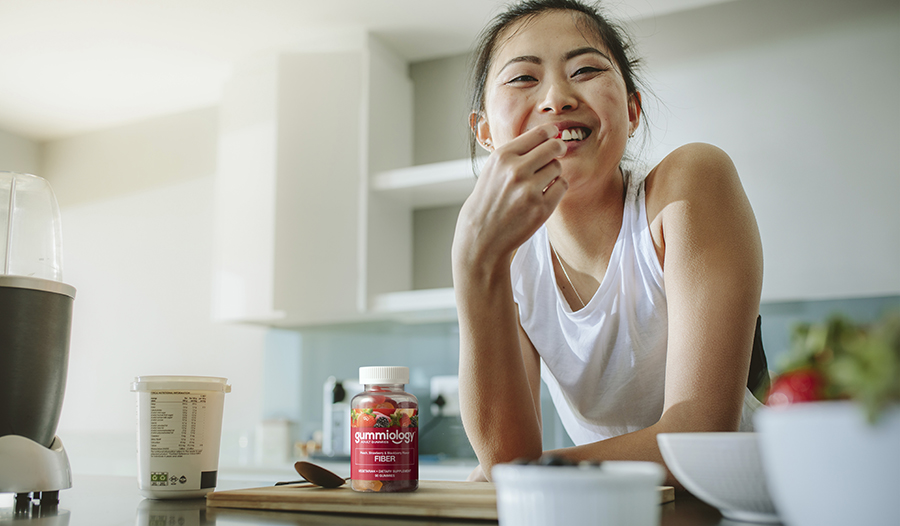Táto živina by mohla byť kľúčom k zdravšej pokožke a lepšiemu tráveniu

Musím prijať - predtým, ako som absolvoval kurzy lekárskej výživy na lekárskej fakulte, vláknina sa mi nezdala taká zaujímavá. Myslel som si, že o tom viem všetko. Beriete to, keď potrebujete ísť do kúpeľne, a to je všetko. Správne?
Nesprávne. O niekoľko rokov výchovy v oblasti výživy neskôr rýchlo vpred a som obrovským zástancom zvýšeného množstva vlákniny v západnej strave. Prečo?
Pretože vláknina je bezpečné a lacné jedlo ako liek, ktoré má množstvo výhod pre celé vaše telo, nielen pre tráviaci trakt. Nie všetky vlákna sú rovnaké, takže na vede skutočne záleží, pokiaľ ide o používanie vlákniny pre vaše zdravie. Tu je pravda.
Vplyv vlákna na zdravie
Vláknina môže pomôcť pri zdravotných stavoch, ako sú alergie, toxicita ťažkých kovov, kognitívne funkcie, astma, kožné vyrážky, zápalové ochorenia čriev, osteoporóza a ďalšie. Existujú dokonca dôkazy, že predlžuje život.
Áno, čítali ste správne. Pravidelná konzumácia vlákniny vám môže pomôcť žiť dlhšie!
Keby existoval liek, ktorý robí všetky veci, ktoré robí vláknina, som presvedčený, že by to bolo milión dolárov za dávku. Ak vezmete do úvahy skutočnosť, že vláknina má tiež veľmi málo vedľajších účinkov, pozeráme sa na neuveriteľne účinnú, bezpečnú a hodnotnú zdravotnú intervenciu, ktorá ďaleko prevyšuje všetky tabletky, ktoré máme.
Pretože toto ovocie a zelenina sú priamo v našom obchode s potravinami, často ich prehliadame alebo ich berieme ako samozrejmosť ako liek. V záujme vašej pokožky, čreva a životnosti by ste mali skutočne dať vlákninu injekciu.
V tomto článku vysvetlím, čo je vláknina, mnoho foriem, v ktorých prichádza, a ako ju efektívne a strategicky používať pre konkrétne zdravotné výhody. Poďme sa ponoriť dovnútra.
Čo je vlákno?
Vlákna sú škroby, ktoré ľudský tráviaci trakt nie je schopný úplne rozložiť na cukor. Vlákna sú druhom uhľohydrátov; pochádzajú iba z rastlinných a obilných potravín, ako je zelenina, hľuzy, obilniny, strukoviny, orechy a semená.
Nemôžete nájsť vlákninu v mäse, vajciach, syroch alebo olejoch. Takže keď hovoríme o vláknine, hovoríme o rastlinách.
Prečo musíte konzumovať vlákninu s vodou
Mnoho ľudí pozná rovnicu vláknina+voda, pokiaľ ide o pohyb vecí tráviacim traktom, ale v prípade, že nie, dovoľte mi objasniť. Vlákno funguje na reguláciu stolice iba vtedy, keď sa konzumuje s vodou.
Táto dôležitá skutočnosť je dôvod, prečo sa vláknité prášky vždy dodávajú s pokynmi na užívanie s veľkým pohárom tekutiny. Čo sa stane, ak si vezmete vlákninu samostatne bez vody? V skutočnosti vás môže spôsobiť zápchu - opak toho, v čo ste pravdepodobne dúfali!
Je to preto, že vláknina a voda v tráviacom systéme vytvárajú zvýšenie osmotického tlaku, ktorý ťahá viac tekutiny cez membrány hrubého čreva. To stimuluje peristaltiku - pohyb v črevách. Bez vody vlákno vytvára viac objemu, ktoré nemá kam ísť. Sedí a nie ste schopní efektívne tlačiť fekálnu hmotu tráviacim traktom.
Čo to pre vás znamená? Len vždy, keď užívate doplnok vlákniny , mali by ste ho vždy užívať vodou alebo podľa pokynov na nádobe. Týmto spôsobom to bude fungovať tak, ako chcete.
Existuje aj niekoľko ďalších spôsobov, ako maximalizovať a biohackovať spotrebu vlákniny.
Zdroje vlákniny
Ovocie a zelenina
Veľkou súčasťou konzumácie čerstvého ovocia a zeleniny ako zdroja vlákniny je, že sú balené s vlastným ideálnym pomerom vlákniny k vode, takže sa nemusíte toľko starať o vodu. To platí aj vtedy, ak jete polosušené ovocie, ako sú sušené slivky.
Potraviny obsahujúce vlákninu zvyčajne chutia vynikajúco a obsahujú množstvo ďalších prospešných zložiek, ktoré pomáhajú posilňovať ľudské zdravie. Jesť avokádové brownie z čiernej fazule vyrobené z bezlepkovej múky je pre mnohých ľudí oveľa zábavnejšie ako užívanie vlákniny.
Našťastie sú obe skvelými možnosťami na zvýšenie počtu vlákien.
Orechy a semená
Ďalšou úžasnou možnosťou pridania väčšieho množstva vlákniny je pridať viac orechov a semien do vašich bežných receptov alebo ako zdravé občerstvenie po celý deň.
Často odporúčam svojim pacientom, aby pridali ľanové semienko a chia semienka do vecí, ako sú ovsené vločky, zmes na pečenie a dokonca aj slané jedlá, ako sú chilli a polievky. Bonusom týchto semien zvyšujúcich vlákninu je, že obsahujú aj omega 3 mastných kyselín, ktoré sú nevyhnutné pre ľudské zdravie.
Doplnky vlákniny
Nakoniec, ak sa vám nepáči alebo nemôžete jesť dostatok ovocia, zeleniny, orechov alebo semien, môžete si každý deň užívať doplnok vlákniny , aby ste sa uistili, že dosiahnete cieľ 25 gramov denne stanovený Americkou asociáciou srdca. Opäť sa uistite, že ste ho užili veľkým množstvom vody.
Fiber vám môže pomôcť detoxikovať každý deň
Môžete myslieť na vlákninu ako na metlu tráviaceho traktu. Pretože zostáva neporušený, a nie rozpúšťa sa do tekutiny v črevách, pomáha vyčistiť odpad podobne ako zametacia metla. Je to skvelá vec, ak sa chcete každý deň cítiť detoxikovaní!
Slovo „detox“ získalo v poslednej dobe trickú kvalitu. Je to nešťastné, pretože naše telá skutočne detoxikujú naše krvné toky a bunky - samy o sebe - každý deň, keď fungujú správne. Je to základná ľudská fyziológia. Ak by ste sa nezbavili odpadových produktov enzymatických reakcií, zomreli by ste. Detoxikácia je prirodzená a dôležitá.
Detoxikácia neprichádza v špeciálnom elixíri alebo tabletke, ale skôr sa deje prirodzene, keď jete správne potraviny, pijete dostatok vody a konzumujete dostatok vlákniny. Tu je veda.
Ako funguje prirodzený detoxikačný proces nášho tela
Naše lymfatické, pečeňové, obličkové, kožné a tráviace systémy sú „emunktórne“ orgánové systémy v tele. Emunktúry sú zodpovedné za vylučovanie škodlivých bioproduktov každej normálnej enzymatickej reakcie v tele, ako aj za toxikanty, s ktorými prichádzame do styku prostredníctvom životného prostredia. Sú to naše prirodzené detoxikačné systémy.
Najmä naša pečeň je zodpovedná za filtrovanie 100% našej krvi každý deň. Vytiahne toxíny a odpadové produkty z krvného obehu a potom tieto toxíny prevedie detoxikáciou fázy prvej a druhej fázy.
Ďalej pečeň balí inaktivované toxíny viazané na zlúčeninu do žlče, ktorá sa ukladá v žlčníku. Žlčník potom vylučuje žlč do tráviaceho traktu, kde sa viaže na vlákna.
Nakoniec toxíny a vlákna, na ktoré sú viazané, sa majú pohybovať z tela ako stolica. Jednoducho povedané - mali by ste tieto toxíny vykačiť!
Teraz si predstavte, čo sa stane, ak nemáte dostatok vlákniny na to, aby sa tieto toxíny mohli viazať, alebo ak nemáte dostatok vlákniny na to, aby ste produkovali aspoň jeden pohyb čriev denne. Toxíny budú sedieť v zažívacom trakte a budú opätovne absorbované do krvného obehu. Postupom času sa hromadia a môžu spôsobiť problémy v tele, ako je zápcha, dysbióza, príznaky dominancie estrogénu (prírastok hmotnosti, akné, PMS, problémy s náladou) a dokonca aj veci ako toxicita ťažkých kovov, ak pracujete alebo žijete v prostredí, kde ste pravidelne vystavení ťažkým kovom, ako je zváranie.
Bez vlákniny nemôžete detoxikovať toľko, ako by ste mali. Zameraním sa na správnu rovnicu vlákna/vody sa však môžete uistiť, že to pre vás nie je problém.
Vláknina môže prospieť zdraviu čriev
Vláknina poskytuje prebiotických škrobov, ktoré potrebujeme na kŕmenie zdravých baktérií (tiež známych ako probiotiká) v našom gastrointestinálnom systéme. Probiotiká sú zodpovedné za udržanie rovnováhy našej črevnej flóry tým, že zabraňujú nadmernému rastu škodlivých baktérií a kvasiniek.
Vďaka zdravej črevnej flóre je menej pravdepodobné, že sa vyskytnú gastrointestinálne príznaky, ako je nadúvanie, poruchy trávenia a citlivosť na jedlo. Tiež zvyšuje pravdepodobnosť, že zažijete čistú pokožku, ako vysvetlíme nižšie.
Spojenie čreva a pokožky a akné
Zdravie čriev priamo ovplyvňuje zdravie pokožky, pretože obe majú jednu spoločnú vec - mikrobióm. Mikrobióm je zbierka baktérií, kvasiniek a ďalších látok, ktoré kolonizujú našu pokožku a povrchy slizníc.
Štúdie ukázali, že v skutočnosti máme v našom tele viac bakteriálnej DNA ako vlastnej DNA. Takto sú baktérie dôležité pre ľudské zdravie!
Zdravé črevo závisí od rozmanitej a divokej škály dobrých baktérií alebo probiotík. Pomáha regulovať pohyblivosť, imunitu a ďalšie, aby veci fungovali tak, ako by mali. Ovplyvňuje tiež celkovú hladinu zápalu, rovnováhu hormónov a tvorbu mazu na pokožke! Je to preto, že mikrobiómy kože a čriev sú spojené. Keď je črevo nezdravé, môže sa stať nezdravá aj pokožka.
Štúdie ukazujú napríklad, že ľudia, ktorí konzumujú diéty bohaté na jednoduché cukry a s nízkym obsahom vláknitých rastlín, majú väčšiu pravdepodobnosť akné a kožných vyrážok ako tí, ktorí konzumujú diéty s nízkym obsahom cukru a celé potraviny. Teoretizujeme, že to môže byť spôsobené zmenami v mikrobióme.
Túto skutočnosť môžete využiť vo svoj prospech! Jedzte veľa zdravých vlákien, aby ste udržali svoje črevo zdravé, a sledujte, ako sa zlepšuje aj vaša pokožka.
Fiber môže pomôcť znížiť kožné vyrážky
Vláknina tiež znižuje dva imunitné procesy, ktoré môžu vytvárať alergické/chronické vyrážky a kožné poruchy, ako je ekzém a psoriáza.
Prvým je degranulácia žírnych buniek. Toto je fantastický termín, ktorý sa vzťahuje na proces, ktorým naše imunitné bunky uvoľňujú histamín - excitačnú molekulu, ktorá spôsobuje netesnosť krvných ciev. Táto netesnosť zase spôsobuje, že sa tekutina šíri na miesto v našej koži a orgánoch tam, kde by nemala. Dostali ste niekedy úle a boli ste schopní vidieť tekutinu v nich? Alebo zápal v hrboľatej vyrážke? To je histamín pre vás!
Zníženie aktivity histamínu je jedným zo spôsobov, ako potenciálne znížiť počet vyrážok, ktoré sa vyskytnú. Jedna štúdia (citovaná v referenčnej časti nižšie) zistila, že vláknina z potravy bola schopná inhibovať degranuláciu žírnych buniek, čím sa znížil počet vyrážok, ktoré ľudia zažili. Stojí za to vyskúšať vlákninu na vyrážky, najmä ak máte podporu svojho lekára pri vyskúšaní tohto prístupu.
Druhé vlákno pomáha znižovať určité typy kožných vyrážok (známe tiež ako atopická dermatitída), pretože znižuje počet imunoglobulínov produkovaných imunitným systémom. Imunoglobulíny sú zodpovedné za množstvo funkcií imunitného systému vrátane alergickej odpovede. Vysoké hladiny imunoglobulínov sú spojené s poruchami, ako je atopická dermatitída, astma a alergie prenášané vzduchom.
Kľúčové upozornenie: Chcete, aby vaše vyrážky zmizli? Zvážte pridanie väčšieho množstva vlákniny do vašej stravy na niekoľko týždňov a všimnite si, či dôjde k zmene. Porozprávajte sa so svojím lekárom o konkrétnejšom pláne pre váš individuálny stav pokožky a počas tohto rozhovoru uveďte vlákninu.
Ako vidíte, vláknina zlepšuje trávenie, pomáha predchádzať črevnej dysbióze, znižuje kožné problémy, ako sú vyrážky a akné, a môže liečiť zápchu. Je to neuveriteľný zdravotný zásah, ktorý chutí skvele, stojí veľmi málo a má rozsiahly, silný vplyv na vaše zdravie.
Referencie:
- Chen, Jia-Ping a kol. „Diétna vláknina a metabolický syndróm: metaanalýza a prehľad súvisiacich mechanizmov.“ Živiny, zv. 10, č. 1, 26. decembra 2017, s. 24, www.ncbi.nlm.nih.gov/pmc/articles/PMC5793252/, 10.3390/nu10010024. Prístup k 17. januáru 2021.
- Chen, Kangning a kol. „Príjem vlákniny a riziko rakoviny endometria: systematický prehľad a metaanalýza.“ Živiny, zv. 10, č. 7, 22. júla 2018, s. 945, www.ncbi.nlm.nih.gov/pmc/articles/PMC6073518/, 10.3390/nu10070945. Prístup k 17. januáru 2021.
- Dai, Zhaoli a kol. „Spojenie medzi príjmom vlákniny a stratou kostí v štúdii Framinghamského potomstva.“ Časopis výskumu kostí a minerálov, zv. 33, č. 2, 7. novembra 2017, s. 241—249, www.ncbi.nlm.nih.gov/pmc/articles/PMC5990003/, 10.1002/jbmr.3308. Prístup k 17. januáru 2021.
- Folkerts, Jelle a kol. „Vplyv vlákniny a metabolitov na aktiváciu žírnych buniek a choroby spojené so žírnymi bunkami.“ Hranice v imunológii, zv. 9, 29. mája 2018, www.ncbi.nlm.nih.gov/pmc/articles/PMC5992428/, 10.3389/fimmu.2018.01067. Prístup k 17. januáru 2021.
- Hogenkamp, Astrid a kol. „Doplnenie myší špecifickými nestráviteľnými oligosacharidmi počas tehotenstva alebo laktácie vedie k zníženej senzibilizácii a alergii u ženských potomkov.“ The Journal of Nutrition, zv. 145, č. 5, 1. apríla 2015, s. 996—1002, pubmed.ncbi.nlm.nih.gov/25833889/, 10.3945/jn.115.210401. Prístup k 17. januáru 2021.
- Kivit, S. a kol. „Galektín-9 indukovaný diétnymi synbiotikami sa podieľa na potlačení alergických symptómov u myší a ľudí.“ Alergia, zv. 67, č. 3, 9. januára 2012, s. 343—352, pubmed.ncbi.nlm.nih.gov/22229637/, 10.1111/j.1398-9995.2011.02771.x. Prístup k 17. januáru 2021.
VYHLÁSENIE: Toto Centrum zdravia a pohody neposkytuje diagnózu,...













































































 Obsah
Obsah

